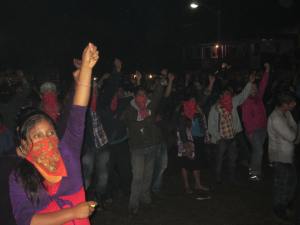New year’s in Caracol III Resistance until a new dawn @ SIPAZ
On 31 December 2013 and 1 January 2014, the Zapatista Army of National Liberation (EZLN) celebrated its twenty-year anniversary of resistance since its insurrection on 1 January 1994, which demanded land, food, work, health, education, housing, justice, and equality for indigenous peoples. The uprising coincided with the entrance into law of the North American Free Trade Agreement (NAFTA). There were celebrations in the five caracoles, with sports games, dance, and food. At 12am, the Mexican and Zapatista flags were presented, while both anthems were sung, as followed by the reading of a communique which mentioned those who are not present, such as Subcomandante Pedro and Comandanta Ramona; as each name was read, a “presente” could be heard cried out.
20 years since its armed uprising, the EZLN spoke to its successes. With regard to health, for example, the Zapatistas have constructed four regional hospitals staffed with surgeons, some of them specializing in reproductive and sexual health, in addition to dozens of municipal clinics, and it estimated that more than 1100 widwives and 1500 herbalists have been trained in this period.
“20 years ago we threw the political parties into the trashcan. We are trying to improve our health, educational, and governmental systems. We know that much remains to be done, but we also know that our struggle will continue,” read Comandanta Hortensia in Caracol II Resistance and Rebellion for Humanity. She added: “We exist and continue here. 20 years ago we had nothing, no system or educational systems based in the people. There was no governmental authority of the people. Now we have our own autonomous governments. Whether it be good or bad, it has been based on the will of the people.”
The bishop from Saltillo, Raúl Vera, indicated that “the rendering visible of the demands and needs of the indigenous peoples of the country who have been among the most marginalized sectors in historical terms has perhaps been the greatest contribution made by the Zapatista Army of National Liberation (EZLN), whose social and political proposals have transformed Mexico and continue to be relevant, though this group does not for the moment dominate the media’s attention.” With the public appearance of the EZLN in January 1994, the conscience was awakened that “we Mexicans cannot continue being inactive. We learned from our indigenous brothers [and sisters] that democracy cannot be attained without efforts and sacrifices, that we will not get out of this if we do not move ourselves from the base, as they have done.”
For more information (in Spanish):
Dar a conocer necesidades indígenas, principal aportación zapatista: Vera(La Jornada, 2 de diciembre de 2014)
Los combates duraron 12 días; la lucha sigue (La Jornada, 31 de diciembre de 2013)
Lanza EZLN nuevo llamado a la rebeldía (Proceso, 1 de enero de 2014)
EZLN gobierna a 250 mil indígenas (Red política, 2 de enero de 2014)
El Ya basta! en América Latina (La Jornada, 27 de diciembre de 2013)
For more information from SIPAZ (in English):
Chiapas: Tens of thousands of Zapatistas mobilize themselves in 5 cities (27 December 2012)
Chiapas: Communiqué by the EZLN: For reflective criticism, individuals and collectives (15 April 2011)
